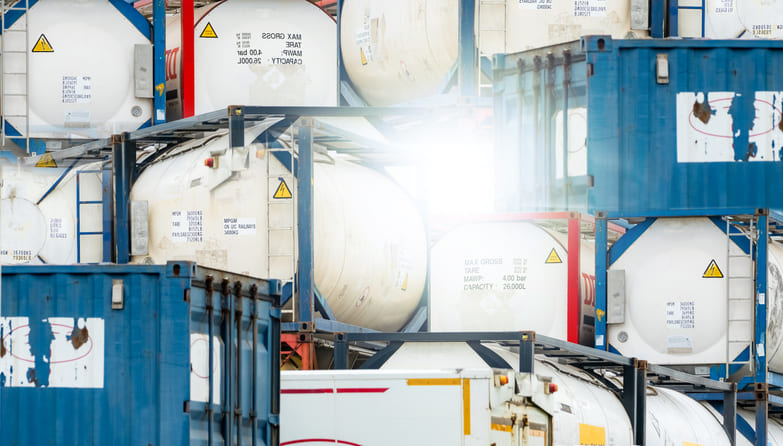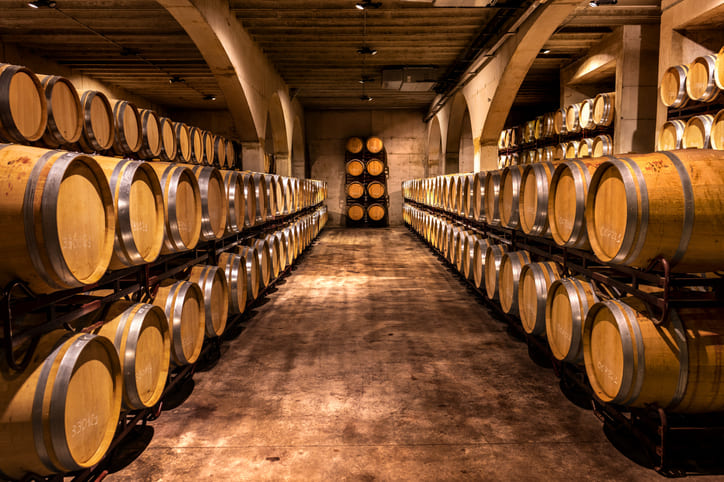16 essential terms to use correctly when transporting wine
Table of contents
Do you know how wine is transported? Do you know the difference between haulage, shipment and freight? Transporting wine often involves a multimodal cargo journey bridging land, sea, or air, and each of these domains have its own specific terminology. Using them incorrectly could appear unprofessional or lead to costly mistakes.
We’ve put together a short glossary of the most common terms you may encounter and explain how to use them correctly.
Transporting wine: the first 12 terms you should know
First, let’s start with the basics. These are some of the most common terms used when talking about shipping and transporting wine:
Cargo
Your wine gets referred to as cargo when it is loaded for transport on a truck, train, airplane or ship. The word cargo refers to the actual thing being transported, whether it is cases, pallets, or containers. In practice, ‘cargo’ is often used interchangeably with the terms shipment, goods, or consignment. Cargo is accompanied by an air waybill, bill of lading, or other contract of carriage.
Case
Cases are the standard way of packing and transporting multiple bottles of wine.
A full case can be 6 or 12 bottles of wine, depending on where it is packed.
In the EU, a full case of wine holds 6 × 750ml bottles of wine.
However, in the US and most other countries, cases come in two capacities:
- Full case: holding 9 liters
- Half case: holding 4.5 liters
A full case will typically hold 12 × 750ml bottles of wine or 6 x Magnums or double bottles. A half case will hold 6 x 750ml bottles and is also used to hold 12 x 375ml dessert bottles or half bottles.
Consignment
The Cambridge Dictionary defines the word consignment as ‘an amount of goods that is sent somewhere’. When it comes to transporting wine, a consignment refers to a single shipment that is being transported from a supplier to a buyer.
Containers
A container is a rigid metal box used to hold large quantities of wine, either in cases on pallets or in a flexitank. Containers are reusable and designed to be easily interchanged between sea, rail, or road transport services. This is called Intermodal transport. Loading and unloading containers can be done using a loading bay at a warehouse with a forklift truck or with a ramp.
When transporting wine, your choice of container is crucial for ensuring your products arrive in perfect condition:
- Dry containers are the cheapest and most available option, but they will not protect your wine from temperature, humidity, or bad odors.
- If you have sensitive products like wine, insulated containers offer more protection than dry containers and defend against thermal shocks, humidity, condensation, cross-contamination, and odors.
- However, if your wine needs to travel in to-the-degree temperatures, you should go with a refrigerated container. Though these are the least environmentally friendly option and availability is unpredictable, they are the safest way to keep a precise temperature and humidity level for your wines.
Freight
Freight is another word commonly interchanged with the word cargo, and applies to goods being transported by water, land, or air. So, for example, you’ll often hear phrases like sea freight, rail freight etc. which is something that is being moved by sea, rail etc. We normally use the word freight when we’re referring to the transport of beverages from one place to another.
Goods
This is a catch-all term for anything movable that is sold and transported. Goods can refer to raw materials or manufactured items.
Haulage
Haulage is a more specific term than freight. Also known as hauling in the US, it was first used to describe the act of moving goods by road or rail because the engine 'hauls' the cargo behind it. Now when trucks, vans, lorries, trailers or trains are transporting wine from one place to another, that is haulage in action. The term is usually used for goods that are being moved from one place to another.
Logistics
Logistics can cover anything involved in moving a product, like wine, from point A to point B. The Cambridge English dictionary defines logistics as: ’the careful organization of a complicated activity so that it happens in a successful and effective way’.
When we’re talking about transporting wine, logistics covers everything along the supply chain from the initial placement of the purchase order up to the wine reaching the customer.
It includes:
- Planning how to move your wine
- Preparing documentation
- Loading configurations
- Arranging transportation
- Getting insurance
- Arranging warehousing and delivery
Many professionals are involved in the logistics of transporting wine, including customs brokers/ agents, carriers and freight forwarders such as Hillebrand Gori.
Pallet
A pallet, sometimes called a skid, is a flat, structure on which cases of wine are stacked. Pallets make it easier to handle, transport, and store wine. A pallet can typically hold between 48 and 56 full 12-bottle cases. One thing to be aware of is that pallets can come in different sizes. The most widely-used exchange pallet in the world is the Euro pallet which measures 800 x 1200mm. Another type of pallet used for transporting wine is the VMF pallet 1000 x 1200mm. This pallet was designed especially for transporting glass and bottles.
Shipping
Shipping is now commonly used to talk about transporting wine from point to point using all modes of transport, but of course, the word originally comes from 'ship' and technically refers only to sea freight. It is the physical movement of goods from one port to another by ship. Sea freight is the most carbon-efficient way of transporting wine and is typically the most cost-effective whether you’re shipping by the bottle, case, or pallet.
Shipment
Shipment can be used to talk about the act of transporting wine by sea or more broadly any means of transport. The entire quantity of what is being transported can also be referred to as a shipment. People often use the terms cargo, consignment or goods as synonyms for shipment.
Transport
Transport is the broadest term on our list. Generally, it is used to talk about moving people or goods from one place to another by land, sea, or air. So you can transport passengers, animals, cars or wine. In the UK, transport also refers to a system of vehicles, such as aircraft, buses, trams, or trains, used to get from one place to another. In the US, this is called transportation.
How wine is transported
Now, let’s go over four terms that describe how wine is transported.
Air freight
Cargo airplanes usually travel at around 900 kilometers per hour, so this is the best choice for goods that have a short shelf life or need urgent delivery. Air freight is also a good option for high-value wines, as air travel offers stringent security measures. When it comes to transporting large quantities of wine, air freight is more flexible than you might think. Entire cargo planes can be chartered to transport even up to 110 tonnes of goods. On the downside, air freight is the most expensive way to move goods and the most environmentally unfriendly. That said, the air sector is on a path to decarbonizing.
Rail freight
Rail freight is a reliable, secure, and efficient way of transporting wine. Freight trains operate on a fixed timetable, rarely stop, and, in most countries, are usually unaffected by delays, weather conditions, or traffic jams. Rail freight is also a more environmentally friendly transport option for moving wine compared to trucks or airplanes. They are a solid choice to help you meet your delivery dates.
Road freight
Road freight, also known as trucking, is the most flexible form of ground transport. It is convenient for transporting wine from door to door within one country or across relatively short distances. One truck can hold up to 1,200 cases or 20 pallets. Trucking usually means less paperwork if your shipment doesn’t cross a border, and it avoids the need for extra handling - unloading and reloading at terminals. However, even if the majority of your cargo’s journey is by ship, rail, or aircraft, your wine will almost certainly be transported by truck at some point along the supply chain.
Sea freight
Sea freight is a cost-effective option for transporting wine internationally. This method involves cargo ships transporting large quantities of wine in containers. Sea freight offers significant cost savings for bulk shipments and has less environmental impact than air travel.
Now that we've answered how wine is transported, you better understand the various methods available to transport it.
When you’re planning how to transport bottles of wine, refer back to this guide to be sure to use the correct term for each part of your cargo’s journey and avoid confusion or expensive misunderstandings.
Of course, transporting wine successfully is about more than getting the terminology right. Contact us to find out how Hillebrand Gori can forward your beverages safely and efficiently to their destination.
Published 10th February 2023, updated 25th March 2024
FCL services enable you to move 10 standard pallets of wine in a 20ft container. Alternatively, flexitanks are a solution for bulk wine transport. These flexible tanks can hold up to 24,000 liters of wine and fit inside a standard 20-foot shipping container.
Europe leads the way in bulk wine transportation, with an annual movement of nearly 16,000 kilotons. North America follows, moving moves half that amount.
Yes, each country has its own laws and regulations regarding importing and exporting alcoholic beverages. It’s important to research and follow these regulations before shipping wine across borders to avoid any legal issues or delays in delivery.
With the growing demand for wine worldwide, the transportation industry is constantly evolving to meet this demand. Gaining momentum is the need for sustainable logistics. This includes using sustainable fuels, reducing carbon emissions and implementing more efficient logistics supply chains.
How can we help your business grow?

.png?sfvrsn=59cab711_1)



